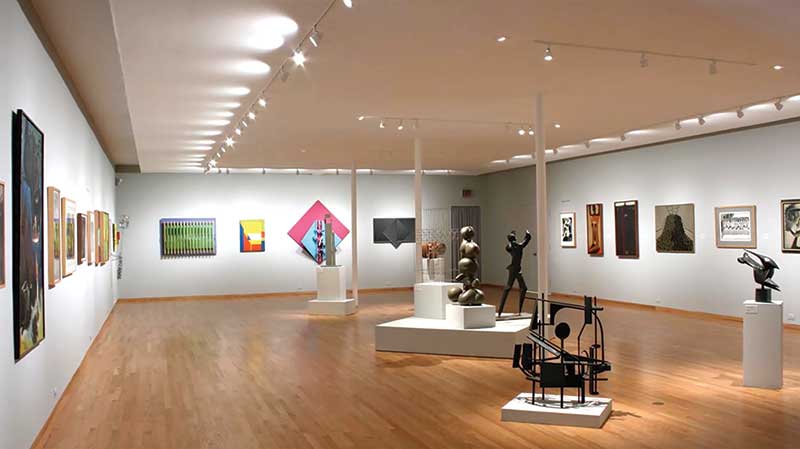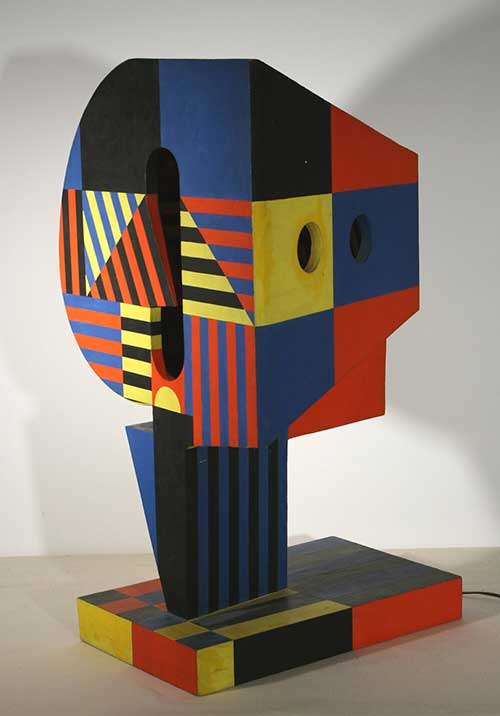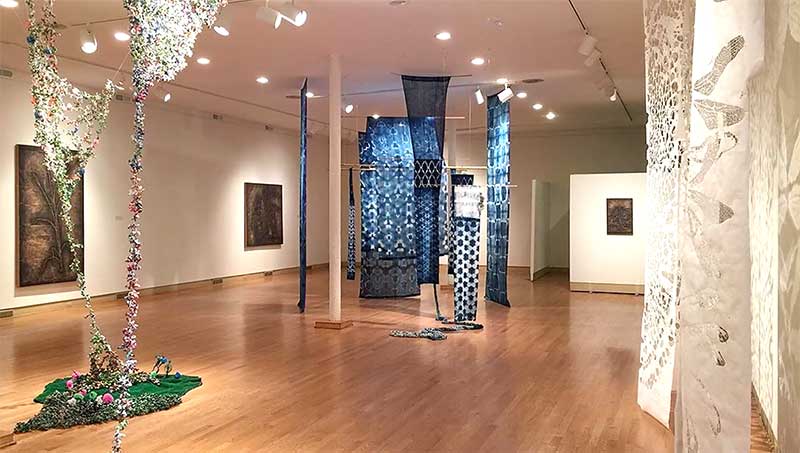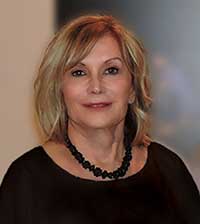Re-discovering the East in the West: Ukrainian Institute of Modern Art


BY ANNA DOBROWOLSKI
Armed with my art gallery guide, mask, and hand sanitizer, I headed out West. West Town, that is. On my mission to rediscover art in a recuperating city, I serendipitously came across the gleamingly white façade of the Ukrainian Institute of Modern Art. Docent Elena Smolynets caught me peeking through the door: “Yes, we are open!” No reservation necessary, I sauntered in. Not only is the UIMA open, it’s also preparing to celebrate 50 years of robust existence.
President Motria Melnyk, curator Adrienne Kochman, and Smolynets—three women who help keep UIMA’s legacy in the heart of Chicago’s Ukrainian Village alive—spoke with me about the UIMA’s history and plans for the future.
Pre-pandemic, the UIMA had an ongoing rotation every six months displaying select works from their permanent collection, which currently houses around 1,200 objects ranging from photography and artifacts to kinetic sculpture. To date the UIMA earned a reputation for having one of the largest collections of Ukrainian art, globally, housing work by Soviet era Ukrainian Non-Conformists such as Alexander Archipenko, Alexis Gritchenko, Mychajlo Andreenko, and other artists of Ukrainian descent. Notably, it features art created by the first generation of artists ever to exhibit with the UIMA, including work by two of its founders: sculptor Konstantin Milonadis and sculptor/painter Mychajlo Urban. It also boasts a growing collection of Chicago-based artists, such as Martin Hurtig, Morris Barazani and Roland Ginzel. Soon (in September) we will be able to appreciate their collection in the context of UIMA’s fast-approaching 50th anniversary.

Now, playing catch up with a pandemic-caused backlog of shows slated for 2020, they are leaving exhibitions up longer for visitors to enjoy in person. During my visit, the permanent collection that would usually inhabit the east gallery space was replaced by 38 paintings from Work, People, Art (WPA): selections from the Works Progress Administration collection of the Illinois State Museum. The label introducing the exhibits of WPA, a child program of President FDR’s New Deal, invites us to “consider whose work and perspectives are missing.” Contrary to all talk about ‘unprecedented times’, there is an uncanny parallel between the work of artists commissioned by the WPA, and the art produced eight decades later. Though there are similarities in context, we are challenged to look deeper and be better: art—then and now— is on the frontline, responding to a shift in values spurred by crisis, social fractures, and economic strife.
Stepping into the west gallery one could relish in Not Afraid, a dual exhibition featuring the abstract, textural sculptural work of Gina Lee Robbins and the bold, expressionist paintings of Janice Elkins. These two self-taught artists hailing form Oak Park regale in the uncertain, and their uninhibited approach to their practice falls in line with the attitudes of the institute’s founding artists.

The U in UIMA
Since its genesis, the UIMA existed as an alternative venue for artists. Following WWII, Konstantin Milonadis and Mychajlo Urban emigrated from Ukraine and met while taking courses at the School of the Art Institute under the GI Bill. While they shared a Ukrainian background, what really drew them together was their love for art that did not fit the status-quo. These artists were experimenting with minimalism, geometric abstraction, and even kinetic media—and it was not just a phase. At the time, they were conscious that these modes of expression were not openly practiced in Ukraine. Curator Adrienne Kochman adds, “When they were working in the late 60s and 70s, Ukraine was still part of the Soviet Union. In the Ukrainian Republic, at least officially, it was forbidden to pursue Western aesthetic modes, such as abstraction, or they would suffer dire consequences such as loss of income or jobs. The official aesthetic, at least in the late 60s, was Soviet socialist realism.” Many of the literary, artistic, and cultural figures who pushed back faced persecution, imprisonment, or death. This “fueled the need to have a safe haven for artists who wanted to work this kind of aesthetic mode outside of Ukraine.”
In Chicago, these artists wanted to explore these ‘modern’ styles without the limitations imposed by larger, often more traditional institutions and sanctioned “academic” styles. To the artists, “Major art institutions like AIC were conservative, and the general feeling was one of ‘If you waited for them to change, they wouldn’t.’”

So, the artists carved out a space for themselves through makeshift art organizations such as the Lion’s Club. The UIMA as we know it was founded through the initiative of prominent doctor and active community member Dr. Achilles and Vera Chreptowsky, and lionhearted artists Konstantin Milonadis and Mychajlo Urban. Thanks to Dr. Achilles and Vera Chreptowsky, who became the patrons, and the efforts of volunteers, the UIMA metamorphosed into a proper institution.
From the onset, the founders were interested in establishing a permanent collection. What started as a way to promote Ukrainian artists born in America or abroad, rapidly evolved into an institution that welcomes all walks of art— and has so for the past 50 years. Of the works they have acquired over the years, Adriene Kochman mentions that “Most donors of the artwork to the collection purchased it directly from the artist, or UIMA did through fundraising and grants specifically awarded for an organization to purchase artwork for its permanent collection. Some of course, were donated directly by the artist.” It is a dream for those studying provenance, and a testament to the close relationship between the artist community and UIMA.
For the 50th anniversary, Kochman hopes to fill both galleries with art from the permanent exhibition so that we can appreciate its scope. Looking ahead, they will continue to welcome all contemporary artists, regardless of nationality: “We will always support Chicago artists! If you have a proposal, please submit it,” says Kochman.
Recent Developments
‘Survived first pandemic’ is just another tick off the list that makes UIMA relevant today in Chicago’s art scene. When the art world was upended over a year ago; staff remained in high spirits. On March 5th, after a mandate caused the institute to shut its doors to the public, they moved their permanent collections to a virtual exhibition space. President Motria, seizing the moment to get creative while taking stock of their collection, created “Corona Story,” to playfully present the artwork set to the upbeat instrumental version of Gloria Gaynor’s classic “I Will Survive.” In addition to uploading videos on the museum’s history to their website, she also created a downloadable activity book for children, complete with QR codes linking to the actual art.
In our Zoom call, she describes her motivation and vision for the Institute, which includes opening up an educational program for young artists. “The founders of the institute not only envisioned an art museum, but also an institution for learning and teaching. Our dream is to incorporate a children’s art center. As an educator, I feel it is important to give young students the opportunities to explore, discover, learn, and express their appreciation and talent for art, enabling them to become life-long art advocates.” says Motria.
Official plans for the 50th anniversary will be announced soon. As ever, plans are tentative, but they will find a way to celebrate and thank all those who made the 50 years possible—artists, patrons, visitors, volunteers. Looking forward, Motria says, “We wait for the day when art exhibition openings, musical concerts, distinguished speakers events, conversations, laughter and energy fills our galleries again.”
For more information about UIMA visit their website






